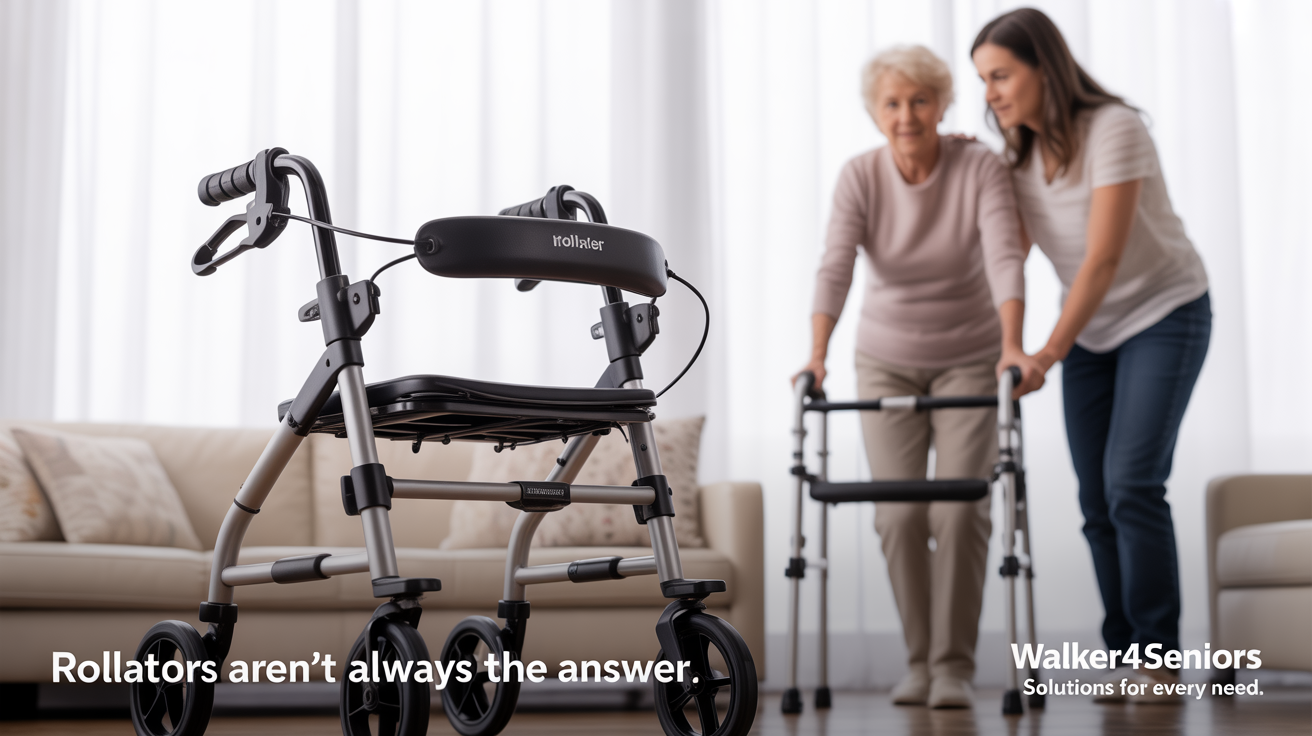TL;DR – Quick Answer
Rollator walkers are not suitable for everyone. You should NOT use a rollator if you have severe balance problems, cannot bear full weight on your legs (post-surgery or fracture), require firm immobile support, have advanced cognitive impairments, severe vision loss, or lack the strength to control hand brakes. A standard walker or wheelchair may be safer alternatives.
Understanding Rollator Walker Limitations
While rollator walkers offer incredible independence for many seniors, they’re not the right mobility solution for everyone. Understanding who should avoid rollators can prevent serious injuries and help you choose the safest mobility aid for your specific needs.
What Makes Rollators Different?
Unlike standard walkers, rollators have wheels that allow continuous movement without lifting. This wheeled design requires different abilities—you must be able to control the rolling motion, operate hand brakes effectively, and maintain balance while the walker moves.
7 Critical Conditions: Who Should NOT Use a Rollator Walker
1. People with Weight-Bearing Restrictions
If your doctor has restricted how much weight you can put on your legs, rollators are unsafe. This includes:
- Post-surgical patients (hip replacement, knee surgery, leg fractures)
- Non-weight-bearing status: Cannot put any weight on affected leg
- Partial weight-bearing status: Limited to specific weight amounts
- Touch weight-bearing status: Only toe-touch allowed for balance
Why it’s dangerous: Rollators aren’t designed to support significant body weight. They provide stability, not weight support. Using a rollator when you can’t fully bear weight could cause re-injury or surgical complications.
Better alternative: Use a standard walker or knee scooter designed for weight-bearing restrictions.
2. Individuals with Severe Balance Problems
Rollators require good baseline balance because they move continuously. You should avoid rollators if you have:
- Frequent dizzy spells or vertigo
- Severe inner ear disorders
- Unsteady gait even with support
- History of falling backward
- Inability to stand independently for 30+ seconds
Why it’s dangerous: The rolling wheels can get away from you during a balance loss, leading to falls rather than preventing them.
Better alternative: Consider a walker with a seat that locks in place, or a four-point standard walker that doesn’t roll.
3. People Needing Firm, Immobile Support
Some conditions require rigid, non-moving support that rollators cannot provide:
- Severe muscle weakness (advanced MS, ALS, muscular dystrophy)
- Significant leg instability
- Difficulty coordinating movement
- Need to lean heavily on the walker to stand
Why it’s dangerous: Rollators move when you lean on them, which can cause loss of balance if you’re depending on firm support.
Better alternative: Standard walkers or walkers for specific medical conditions that remain stationary.
4. Seniors with Advanced Cognitive Impairment
Rollators require multiple cognitive functions working together. They may be unsafe for people with:
- Moderate to severe dementia or Alzheimer’s disease
- Significant memory loss affecting safety awareness
- Inability to remember to use hand brakes
- Confusion about how to operate the walker
- Poor judgment about obstacles or hazards
Why it’s dangerous: Forgetting to lock brakes before sitting, rolling into traffic, or misjudging doorways can cause serious injuries.
Better alternative: Supervised walking with walkers that have additional safety features, or a wheelchair for advanced stages.
5. Individuals with Severe Vision Impairment
Rollators require seeing obstacles, curbs, and terrain changes. Avoid rollators if you have:
- Legal blindness or near-blindness
- Advanced macular degeneration
- Significant visual field cuts (hemianopia from stroke)
- Severe cataracts limiting vision
- Inability to judge distances or depth
Why it’s dangerous: You cannot avoid obstacles, judge curb heights, or navigate safely around hazards you can’t see clearly.
Better alternative: Standard walker with tactile feedback or a white cane, depending on mobility needs.
6. Those Unable to Operate Hand Brakes
Rollator safety depends entirely on brake control. You should not use rollators if you:
- Have severe arthritis limiting hand strength
- Experience hand tremors preventing precise control
- Have paralysis or weakness in hands/wrists
- Lack coordination to squeeze brakes while walking
- Cannot reach or grip the brake handles
Why it’s dangerous: Without brake control, the rollator can roll away on slopes or when you need to stop, causing falls.
Better alternative: Lightweight rollators with foot-operated brakes, or standard walkers without wheels.
7. People Unable to Stand Unassisted
If you cannot stand up from a chair without significant help, rollators may be inappropriate:
- Requiring two-person assistance to stand
- Unable to transfer from chair to standing
- Extreme weakness preventing standing
- Complete leg paralysis
Why it’s dangerous: If you can’t stand to get into position to use the rollator safely, it won’t provide adequate support.
Better alternative: Wheelchair or motorized mobility scooter.
Rollator vs. Standard Walker: Which Is Right for You?
Comparison Table
| Factor | Rollator Walker | Standard Walker | Who It’s Best For |
|---|---|---|---|
| Weight Support | Light stability only | Moderate to significant support | Rollator: Good balance, full weight-bearing Standard: Post-surgery, fractures |
| Balance Required | Good balance needed | Can assist poor balance | Rollator: Steady on feet Standard: Unsteady, frequent dizziness |
| Cognitive Function | Must remember brakes | Simpler operation | Rollator: Good memory Standard: Cognitive issues |
| Hand Strength | Must squeeze brakes | Less grip required | Rollator: Strong hands Standard: Weak grip, arthritis |
| Cost | $$-$$$ ($100-$400) | $-$$ ($30-$150) | Both: Check Medicare coverage |
Warning Signs You’re Using the Wrong Walker
Even if you initially could use a rollator safely, conditions change. Switch to a different mobility aid if you experience:
- Frequent close calls: Nearly falling or walker getting away from you
- Brake struggles: Difficulty remembering or operating brakes
- Increased falls: More falls after starting rollator use
- Leaning heavily: Depending on rollator for weight support
- Confusion: Forgetting how to use the walker properly
- Fear: Anxiety about using the rollator
- Physical decline: Weakness or balance worsening
Medical Conditions Requiring Special Consideration
Can Use Rollators WITH Modifications:
- Mild arthritis: Walkers with ergonomic grips
- Mild Parkinson’s: Specialized walkers with laser guides
- Obesity: Bariatric walkers for heavy seniors (up to 500 lbs)
- Mild vision issues: With corrective lenses and good lighting
- Stable heart conditions: After doctor approval
Cannot Safely Use Rollators:
- Severe orthostatic hypotension (sudden blood pressure drops)
- Advanced neurological conditions without adaptations
- Acute injuries requiring immobilization
- Uncontrolled seizure disorders
- Severe chronic pain limiting mobility
How to Know If You Need a Different Walker
Assessment Questions:
- Can you stand independently for at least 30 seconds? (No = consider wheelchair)
- Can you bear full weight on both legs? (No = avoid rollators)
- Do you have good balance without support? (No = standard walker better)
- Can you squeeze hand brakes firmly while walking? (No = avoid rollators)
- Can you remember to lock brakes before sitting? (No = avoid rollators)
- Do you see obstacles and curbs clearly? (No = avoid rollators)
- Are you strong enough to control the rollator on slopes? (No = avoid rollators)
If you answered “no” to 2 or more questions, consult your doctor or physical therapist before choosing a rollator.
Safe Alternatives to Rollator Walkers
When Rollators Aren’t Right:
-
Standard walkers: Best for post-surgery, severe balance issues, and those needing maximum support -
Upright walkers: Better posture support for back problems -
Knee scooters: Ideal for lower leg injuries with weight-bearing restrictions -
Wheelchairs: For those unable to stand or walk safely -
All-terrain walkers: Modified rollators with enhanced stability features -
Canes or walking sticks: For minimal support needs
Frequently Asked Questions (FAQ)
Can I use a rollator walker after hip surgery?
Not immediately. After hip surgery or fractures with weight-bearing restrictions, rollators are unsafe because they’re not designed to carry significant body weight. Wait until your doctor clears you for full weight-bearing status, typically 6-12 weeks post-surgery. Start with a standard walker, then transition to a rollator during recovery.
Are rollators safe for people with dementia?
People with severe cognitive impairments should not use rollator walkers due to safety concerns. Those with mild dementia may use rollators under supervision, but advanced stages require alternatives. The main risks include forgetting to lock brakes before sitting and poor judgment about obstacles.
Can someone with arthritis use a rollator walker?
Yes, but with considerations. Mild to moderate arthritis is manageable with walkers featuring ergonomic grips. However, severe arthritis that prevents brake operation makes rollators unsafe. Consider walkers with loop brakes that require less grip strength, or foot-operated brake systems.
What if I have balance problems but want to use a rollator?
Individuals with severe balance problems requiring firm, immobile support should not use rollators. A standard walker provides the stable support needed. Have a physical therapist assess your balance before choosing a rollator. If you pass balance tests, start with supervised practice.
Can I use a rollator if I’m obese or overweight?
Absolutely! Being overweight doesn’t disqualify you from rollators. Instead, choose bariatric walkers specifically designed for heavy seniors, which support up to 500 pounds. These feature reinforced frames and wider bases for enhanced stability.
Are rollator walkers covered by Medicare?
Yes! Medicare-approved walkers, including rollators, are covered under Medicare Part B when medically necessary and prescribed by your doctor. Medicare covers 80% of the cost, and supplemental insurance often covers the remaining 20%.
Can vision problems prevent rollator use?
Severe visual impairment including legal blindness, advanced macular degeneration, or significant visual field cuts makes rollators unsafe because users cannot reliably spot and avoid obstacles. Mild vision issues correctable with glasses are usually fine.
Expert Recommendations: Choosing the Right Mobility Aid
Consult These Professionals:
- Physical Therapist: Best for walker selection and training
- Occupational Therapist: Assesses home safety and daily living needs
- Physician: Medical clearance and prescription
- Durable Medical Equipment Specialist: Proper fitting and adjustments
Professional Assessment Includes:
- Gait analysis and balance testing
- Strength and range of motion evaluation
- Cognitive function screening
- Home environment assessment
- Medical history review
Taking the Next Step Toward Safe Mobility
Choosing the wrong walker can be dangerous, but choosing the right one transforms independence and quality of life. If rollators aren’t suitable for your situation, don’t feel discouraged—numerous alternatives can meet your specific needs safely.
Your Action Plan:
- Assess your situation using the questions in this guide
- Consult your doctor or physical therapist for professional evaluation
- Explore alternatives like standard walkers, upright walkers, or specialty models
- Consider trial periods to test different options
- Prioritize safety over convenience or appearance
Remember, mobility aids exist to improve your life safely. The right walker—whether rollator or alternative—should make you feel confident, not fearful.
Need Help Choosing the Right Walker?
If you’re unsure whether a rollator is right for you, our mobility specialists can help. We offer:
- Free video consultations with trained professionals
- Comprehensive walker assessments
- Medicare-approved options with documentation support
- 30-day trial periods on select models
- Expert guidance on walkers for specific conditions
Explore safe alternatives:
- Best walkers for seniors with balance problems
- Lightweight travel-friendly walkers
- Post-surgical recovery walkers
- Heavy-duty bariatric walkers
Your safety and independence matter. Let us help you find the perfect mobility solution for your unique needs.
Medical Disclaimer: This article provides general information only and should not replace professional medical advice. Always consult your physician, physical therapist, or healthcare provider before selecting a mobility aid. Individual needs vary, and only qualified professionals can assess your specific situation safely.

